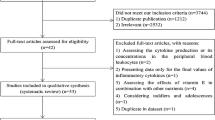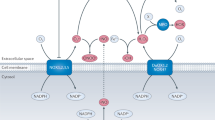Abstract
Rheumatoid arthritis is an autoimmune-mediated inflammatory disease of unknown etiology, and is characterized by joint pain and soft-tissue swelling. The role of dietary antioxidants in the prevention and amelioration of symptoms in inflammatory joint disease has been of interest for many years. Epidemiological studies provide evidence of a link between dietary antioxidant intake and the likelihood of developing inflammatory arthritis. Interventional studies of antioxidant supplementation in established disease have been inconclusive overall; however, the quality of such studies has often been poor. The pathways by which antioxidant compounds might act are now better understood. In this Review, we explore not only some of the accepted mechanisms of antioxidant function but also outline some concepts that could aid further investigation of the potential therapeutic role of dietary antioxidants in inflammatory arthritis.
Key Points
-
Oxidative stress is frequently related to diseases that have an inflammatory component, such as inflammatory arthritis
-
Epidemiological evidence suggests that dietary antioxidants can diminish the oxidative stress associated with inflammatory arthritis
-
Dietary antioxidants might confer protective properties through mechanisms unrelated to conventional antioxidant properties
-
Future research is needed to clarify the mechanisms of action of dietary antioxidants, their bioavailability in humans and the quantities required to promote health
-
Current evidence does not support the use of antioxidant nutraceuticals in the management of inflammatory arthritis
This is a preview of subscription content, access via your institution
Access options
Subscribe to this journal
Receive 12 print issues and online access
$209.00 per year
only $17.42 per issue
Buy this article
- Purchase on Springer Link
- Instant access to full article PDF
Prices may be subject to local taxes which are calculated during checkout




Similar content being viewed by others
References
Symmons DP et al. (1994) The incidence of rheumatoid arthritis in the United Kingdom: results from the Norfolk Arthritis Register. Br J Rheumatol 33: 735–739
Karlson EW et al. (2008) Associations between human leukocyte antigen, PTPN22, CTLA4 genotypes and rheumatoid arthritis phenotypes of autoantibody status, age at diagnosis and erosions in a large cohort study. Ann Rheum Dis 67: 358–363
Symmons DPM et al. (2000) Early inflammatory polyarthritis: results from the Norfolk Arthritis Register with a review of the literature. I. Risk factors for the development of inflammatory polyarthritis and rheumatoid arthritis. Rheumatology (Oxford) 39: 835–843
Aho K and Heliövaara M (2004) Risk factors for rheumatoid arthritis. Ann Med 36: 242–251
Pattison DJ et al. (2004) Does diet have a role in the aetiology of rheumatoid arthritis? Proc Nutr Soc 63: 137–143
Arts IC and Hollman PC (2005) Polyphenols and disease risk in epidemiologic studies. Am J Clin Nutr 81 (Suppl 1): 317S–325S
Halliwell B and Gutteridge JMC (1999) Free Radicals in Biology and Medicine (edn 3) New York: Oxford University Press, USA
Sies H (1997) Preface. In Antioxidants in Disease Mechanisms and Therapy, xxiii (Eds Packer et al.) London: Academic Press
Winyard PG et al. (2005) Oxidative activation of antioxidant defence. Trends Biochem Sci 30: 453–461
Jones OTG and Hancock JT (2000) The NADPH oxidase of neutrophils and other cells. In Free Radicals and Inflammation, 21–46 (Eds Winyard PG et al.) Basel: Birkhauser
Karunasinghe N et al. (2006) Hemolysate thioredoxin reductase and glutathione peroxidase activities correlate with serum selenium in a group of New Zealand men at high prostate cancer risk. J Nutr 136: 2232–2235
Rinehart JF et al. (1936) Reduced ascorbic acid content of blood plasma in rheumatoid arthritis. Proc Soc Exp Bol Med 35: 347–350
Fairburn K et al. (1992) Alpha-tocopherol, lipids and lipoproteins in knee-joint synovial fluid and serum from patients with inflammatory joint disease. Clin Sci (Lond) 83: 657–664
Lunec J and Blake DR (1985) The determination of dehydroascorbic acid and ascorbic acid in the serum and synovial fluid of patients with rheumatoid arthritis (RA). Free Radic Res Commun 1: 31–39
Canter PH et al. (2007) The antioxidant vitamins A, C, E and selenium in the treatment of arthritis: a systematic review of randomized clinical trials. Rheumatology (Oxford) 46: 1223–1233
Edmonds SE et al. (1997) Putative analgesic activity of repeated oral doses of vitamin E in the treatment of rheumatoid arthritis. Results of a prospective placebo controlled double blind trial. Ann Rheum Dis 56: 649–655
Winrow VR et al. (1993) Free radicals in inflammation: second messengers and mediators of tissue destruction. Br Med Bull 49: 506–522
Bjelakovic G et al. (2007) Mortality in randomized trials of antioxidant supplements for primary and secondary prevention: systematic review and meta-analysis. JAMA 297: 842–857
Willett WC et al. (1995) Mediterranean diet pyramid: a cultural model for healthy eating. Am J Clin Nutr 61 (Suppl 6): 1402S–1406S
Sköldstam L et al. (2003) An experimental study of a Mediterranean diet intervention for patients with rheumatoid arthritis. Ann Rheum Dis 62: 208–214
McKellar G et al. (2007) A pilot study of a Mediterranean-type diet intervention in female patients with rheumatoid arthritis living in areas of social deprivation in Glasgow. Ann Rheum Dis 66: 1239–1243
Pattison DJ et al. (2004) The role of diet in susceptibility to rheumatoid arthritis: a systematic review. J Rheumatol 31: 1310–1319
Linos A et al. (1999) Dietary factors in relation to rheumatoid arthritis: a role for olive oil and cooked vegetables? Am J Clin Nutr 70: 1077–1082
Pattison DJ et al. (2004) Vitamin C and the risk of developing inflammatory polyarthritis: a prospective nested case control study. Ann Rheum Dis 63: 843–847
Cerhan JR et al. (2003) Antioxidant micronutrients and risk of rheumatoid arthritis in a cohort of older women. Am J Epidemiol 157: 345–354
Pedersen M et al. (2005) Diet and risk of rheumatoid arthritis in a prospective cohort. J Rheumatol 32: 1249–1252
Shapiro JA et al. (1996) Diet and rheumatoid arthritis in women: a possible protective effect of fish consumption. Epidemiology 7: 256–263
Pattison DJ et al. (2005) Dietary beta-cryptoxanthin and inflammatory polyarthritis: results from a population-based prospective study. Am J Clin Nutr 82: 451–455
Heliövaara M et al. (1994) Serum antioxidants and risk of rheumatoid arthritis. Ann Rheum Dis 53: 51–53
Comstock GW et al. (1997) Serum concentrations of alpha-tocopherol, beta-carotene, and retinol preceding the diagnosis of rheumatoid arthritis and systemic lupus erythematosus. Ann Rheum Dis 56: 323–325
Knekt P et al. (2000) Serum selenium, serum alpha-tocopherol, and the risk of rheumatoid arthritis. Epidemiology 11: 402–405
Bashir S et al. (1993) Oxidative DNA damage and cellular sensitivity to oxidative stress in human autoimmune diseases. Ann Rheum Dis 52: 659–666
Tak PP (2000) Rheumatoid arthritis and p53: how oxidative stress might alter the course of inflammatory diseases. Immunol Today 21: 78–82
Eggleton P et al. (2008) Consequence of neo-antigenicity of the 'altered self'. Rheumatology (Oxford) 47: 567–571
Reddanna P et al. (1985) Inhibition of 5-lipoxygenase by vitamin E. FEBS Lett. 193: 39–43
Douglas C et al. (1986) Vitamin E inhibits platelet phospholipase A2 . Biochim Biophys Acta 876: 639–645
Azzi A (2007) Molecular mechanism of alpha-tocopherol action. Free Radical Biol Med 43: 16–21
Stocker R and Keaney JF Jr (2004) Role of oxidative modifications in atherosclerosis. Physiol Rev 84: 1381–1478
Premkumar K and Bowlus CL (2004) Ascorbic acid does not increase the oxidative stress induced by dietary iron in C3H mice. J Nutr 134: 435–438
Hultqvist M et al. (2006) A new arthritis therapy with oxidative burst inducers. PLoS Med 3: e348
Acknowledgements
The authors thank Joanna Tarr for her help with preparing Figure 2.
Author information
Authors and Affiliations
Corresponding author
Ethics declarations
Competing interests
The authors declare no competing financial interests.
Rights and permissions
About this article
Cite this article
Pattison, D., Winyard, P. Dietary antioxidants in inflammatory arthritis: do they have any role in etiology or therapy?. Nat Rev Rheumatol 4, 590–596 (2008). https://doi.org/10.1038/ncprheum0920
Received:
Accepted:
Published:
Issue Date:
DOI: https://doi.org/10.1038/ncprheum0920
This article is cited by
-
A Study on Association Between Protein Carbonyl and Anti-cyclic Citrullinated Peptide Antibody in Rheumatoid Arthritis: Introducing a New Supplementary Biomarker
Indian Journal of Clinical Biochemistry (2020)
-
Associations between paraoxonase 1 (PON1) polymorphisms and susceptibility and PON1 activity in rheumatoid arthritis patients, and comparison of PON1 activity in patients and controls: a meta-analysis
Clinical Rheumatology (2019)
-
L-cystathionine inhibits oxidized low density lipoprotein-induced THP-1-derived macrophage inflammatory cytokine monocyte chemoattractant protein-1 generation via the NF-κB pathway
Scientific Reports (2015)
-
Ameliorative effect of p-coumaric acid, a common dietary phenol, on adjuvant-induced arthritis in rats
Rheumatology International (2013)



